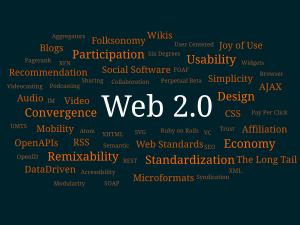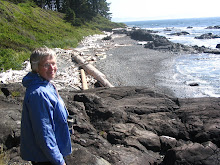 Image via Wikipedia
Image via Wikipedia
I searched one of the blogs I am following by G. Siemens for the tag "folksonomy". In his blogs, it appears only once in a blog post on February 4, 2005. At that point (according to the comments and other links to other blogs) IT people in the forefront of the learning curve were arguing over the meaning of folksonomy. According to my understanding of folksonomy, it is grassroots tagging (metadata) of information. It's done by the folks or the community. It is not heirarchical although when I see a tag cloud (is that what it's called), those which are used more often are typed in larger font. Generally the larger font ones are also more general.
As an example, go to G. Siemens blog and scroll down to see the Tags on the right hand side. Blogging and Learning are writ large while legal and semantic web are in tiny
 Image by eszter via Flickr
Image by eszter via Flickr
Some people don't like the use of the word metadata for the free tagging process. Metadata provides a controlled set with subsets of tags. However, what I am noticing with my trial of Delicious for bookmarking is that I can create my own tags but Delicious gives me suggestions of other tags which are part of the public metadata set. Delicious also reminds me of the tags I have already created so that I can more easily follow the breadcrumb trail back to the source when I need it again.
Recently I have been packing up my classroom since I am going to university full-time in the fall. I have been working with my files. In my early years as a teacher, I would file something under Canada or animals. However, later on, I began to organize more subject specifically (Social Studies-Grade 5-Canada-research project). Which file folders are more easily accessible for me? Of course, the ones with more specific descriptions.
One blogger talked about the problem with tags which are too general (like summer on a Flickr photo as a tag). He suggested that the more a person uses tags and tries to retrieve information or files or pictures, the more that person will develop those tags which will best fit their intuitive process of information retrieval.
What are the implications for our students? Vanderwal comments on January 7, 2005 that "early education systems must teach information organizing methods and techniques". He says that he learned to use the Dewey decimal system in grade one and never forgot it after that. How could we teach these kinds of skills to students? With my grade one and two students this year, I did lots of work with webbing, similar to a concept map. The students needed to think of categories as they read or needed to create categories to provide fodder for writing. As well, we examined non-fiction books for text features which helped to organize information (captions, glossaries, content pages, diagrams, etc.). In math we did lots of work with patterning and attribute finding and categorizing. I think that kind of work would all assist students in moving toward the information organizing methods and techniques that will be required to create and use the folksonomies of the future. (Check out this slideshow at Slideshare about folksonomy.)
I finished reading through all the comments for this blog post by Louis Rosenfeld on January 6, 2005. People who work for Flickr and many early adopters weigh in with their thoughts on taxonomies and metadata and folksonomies. I love history and knowing the roots of movements. I love this stuff.
Now to relate all of this to the use of social bookmarking--previously I organized my Favourites according to Folders with files inside them. I often had sub-folders. Example: Science Folder with Ocean Folder inside it with Ocean Animal Folder inside that. Obviously the folder names were my way of tagging the information. Where this broke down was when I had twenty sites bookmarked under Ocean Animals but did not know unless I opened each one, which site had that interesting webcam showing the penguins at the San Diego Zoo. Now with Delicious I can tag each site with words relating to what I want to remember about the site. I can also include
 Folksonomy 2x2" style="border: medium none ; display: block;" width="240" height="240">Image by Ross Mayfield via Flickr
Folksonomy 2x2" style="border: medium none ; display: block;" width="240" height="240">Image by Ross Mayfield via Flickr
One interesting thing about Flickr is that the people can gradually influence each other to use the same tags or metadata for similar types of photos. I'm not quite sure how that works (something about the Squared Circle group). After reading all of this stuff for many hours, it becomes a little blurred in my mind--where did I read this or that?
The last thing I'm going to include in this post is a reference to the article I referred to yesterday (the one I have the PDF file for). Here are some quotes from that article about moving beyond Web 2.0 to Web 3.0. "The use of the social software is generating an impressive growth in the quantity of contents
 Image by mushon via Flickr
Image by mushon via Flickr
Web 1.0 or static
Web 2.0 or the Social Web offers a great innovation potential in social relationship, business and education
Web 3.0 or Semantic Web, . . . focused on meanings representations, connecting knowledge, and [putting] them to work in a way that the internet use experience can be more relevant, useful and fun
Web 4.0 will be the one that connects intelligences through an extended Web where people and things can reason and communicate together"
Reference: Piedra, N., Chicaiza, J., Lopez, J., Tovar, E., & Martinez, O. (2009). Open educational practices and resources based on social software, UTPL experience. American Conference On Telematics and Information Systems: Proceedings of the 2009 Euro American Conference on Telematics and Information Systems: New Opportunities to increase Digital Citizenship, Prague, Czech Republic, Article 34, DOI: http://doi.acm.org/10.1145/1551722.1551756
This means that tagging data is the wave of the future. I look forward to creating more bits of metadata once and using them many times in the future.
 Reblog this post [with Zemanta]">
Reblog this post [with Zemanta]">




Hi Ruth,
ReplyDeleteI instantly enjoyed bookmarking but it is going to take me a while to find my tagging comfort zone. I have bookmarked many Del.icio.us links and do like that I can create my own tags and that recommended tags are also provided. It will take some time and practice though for me to find effective ways to keep everything orderly without the use of the folders and same favouriting techniques you mentioned in your blog. Are you enjoying the transition and finding ways to accomodate for not having a folder system? Nice overview of the topic!
~:) Heather
Hi Ruth,
ReplyDeleteYou bring up some interesting points - I think you can work with your little ones to understand "controlled vocabulary" vs. their categories, tags, etc.
There is a lot for little ones to learn about Dewey and how information is organized in libraries that can help them be better web searchers (when they get older). Using your categories and sorting ideas and then working with information books in their school library can really bring it all together and help them transfer that knowledge.
Exciting stuff.